
Below: This photo shows the TC tracks and may have been taken from the driveway of the garage noted above. (January 1, 1935, by H. F. Spivey, Santa Fe Railway Historical & Modeling Society collection)

A Crossing of the Texas Central Railway and the Gulf, Colorado & Santa Fe Railway
 |
Left: Tower 50 was a
combination depot and tower, a Santa Fe design similar to
McGregor farther south. If the date of this photo
of Tower 50 and the union depot at Morgan is accurate, the tower existed
long before
it was approved to host
an interlocker in 1904. The Santa Fe tracks are in the foreground and the Texas
Central (TC) tracks pass between the tower and the garage at far left.
Note what appears to be a hotel behind the depot. (Mark Nerren
collection) Below: This photo shows the TC tracks and may have been taken from the driveway of the garage noted above. (January 1, 1935, by H. F. Spivey, Santa Fe Railway Historical & Modeling Society collection)  |
As the Houston & Texas Central (H&TC) Railway was
building north out of Houston toward the Red River, tracks had been laid through Hearne and Bremond
into Groesbeck
by the end of 1870. Bremond
was significant because it was the target of the Waco Tap Railroad, which had been chartered with the intent
to "tap" the H&TC main line to bring rail service to
Waco. The
project was mostly dormant, but conveniently for the Waco Tap, H&TC's investors
had been looking at the prospect of building a lengthy branch line into the
Texas Panhandle. Waco was the obvious gateway in that direction, hence,
negotiations ensued to see what might be done under the Tap's existing charter.
To convey H&TC's long range intent, a law passed by the Texas
Legislature on August 6, 1870 established Waco & Northwestern (W&NW)
Railway as the new name for the Waco Tap. The
branch out of Bremond to Waco was completed for the W&NW by H&TC's construction forces in September, 1872.
An 11-mile extension north from Waco to Ross was also built. There was nothing
special about the tiny community of Ross, so this short track segment was apparently meant to convey
the sincerity of H&TC's intent to build toward the
Panhandle. The W&NW was formally bought by the H&TC in 1873 and then operated as
a subsidiary. By that time, the H&TC main line had reached
Denison and connected with the Missouri
- Kansas - Texas ("Katy") Railroad which had bridged the Red River
from Oklahoma into Texas.
The branch to Waco was not the first
one built by the H&TC. Before the Civil War, the H&TC had taken over the
Washington County Rail Road, a broad-gauge (5 1/2 ft.) line out of
Brenham, and
completed it to the H&TC main line at Hempstead (which required bridging the Brazos
River in 1861.) Later, the Brenham branch was extended west to Austin where the last
spike was driven on Christmas Day, 1871 (and the entire branch was converted to
standard gauge in 1877.) For the towns along the main line and the branches
to Austin and Waco, the H&TC provided direct service to Houston, quickly developing as both a port and a shipping hub with rail connections to
Galveston.
The H&TC
attracted the attention of Charles Morgan, owner of a major steamship line
operating in the Gulf of Mexico. Morgan had recognized the need to acquire
railroads to move goods in and out of the major ports servicing his steamship
line. To this end, he organized Morgan's Louisiana and Texas Railroad and
Steamship Company and then bought the H&TC in early 1877, naming his son-in-law,
Charles Whitney, as President. With Morgan and his family now in control, the
H&TC and its
investors refocused on the northwest extension, quickly discovering
that its
importance had increased for an unanticipated reason. Almost all of the
land grant certificates awarded by the State of Texas for H&TC's main
line construction needed to be surveyed and patented in the Panhandle; there was
not enough state-owned land elsewhere to fulfill the grant. This simply
reinforced the need to build a branch line to the Panhandle, and to do so, they
chartered a new railroad on May 30, 1879 which they named the Texas Central (TC) Railway. The
TC would build the northwest branch
out of Ross along with another branch off the main line at Ennis that would proceed northeast to
Paris.
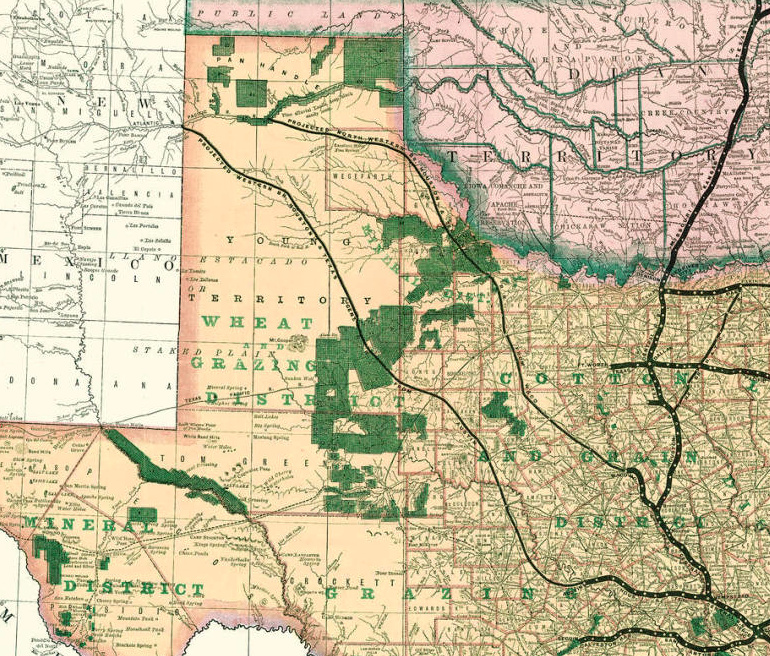 |
Left: This 1876 map of Texas railroads
incorporated H&TC's projections for two
lengthy branch lines running northwest into the Texas Panhandle. One would
continue out of Austin to reach the New Mexico border in Oldham
County, Texas. The other out of Waco would reach
the Canadian River in Potter County, Texas. Amarillo, the future county
seat of Potter County, would be founded 18 miles south of the river a
decade after this map was created. H&TC's investors anticipated that both of these branches would connect to the Atlantic & Pacific (A&P) Railroad. The A&P was a company chartered by Congress to build a transcontinental route from Springfield, Missouri to the Pacific Ocean, generally along the 35th parallel. Eastern and western portions of the A&P were built, but for a variety of financial reasons, the entire route was never completed. In particular, the tracks in the central part of its planned route were never built. Its western tracks became part of the Atchison, Topeka & Santa Fe Railway while its eastern tracks became part of the St. Louis & San Francisco Railway. While construction of a branch line toward the Panhandle proceeded north and west out of Ross with considerable progress, the branch out of Austin never really materialized. A railroad, the Austin & Northwestern, was chartered and built sixty miles to Burnet in 1882, but it was narrow gauge and not apparently affiliated with the H&TC's investors. It mostly served granite quarries in the area and was extended to Llano, but went no farther northwest. (map courtesy of the Texas General Land Office) |
Work on the northwest
extension out of Ross appears to have commenced in 1879, soon after the TC was
chartered. Route planning had to account for crossing the Brazos
River which was only about five miles west of Ross. The TC right-of-way (ROW)
went north and remained at least three miles east of the Brazos until it
neared the new town of Whitney, founded by the TC and named for H&TC President
Charles Whitney. There, it curved west, passed through the center of the new town, and
then turned slightly southwest for five miles toward the Brazos. Just before
reaching the river, the tracks made a 90-degree curve and crossed the new bridge on a north-northwest heading.
This unusual path was chosen presumably for bridge engineering
and cost reasons since it lowered
the track elevation more than 40 feet before crossing the river on a 520 ft.
bridge.
An article in the Whitney
Messenger of July 27, 1893 describes the history of the town and explains
that... "The town of Whitney...is a few months less than fourteen years old,
the lots having been sold on November 25, 1879." The
Handbook of Texas agrees with this date for
selling town lots, but claims that Whitney "...was established in 1876 when
the Houston and Texas Central Railroad built a line through Hill County to
Cleburne." This is simply a mistake. While there was public
speculation about the W&NW's plans after reaching Ross, no railroad named TC, H&TC or W&NW
ever built to Cleburne, and the TC didn't start
building out of Ross until 1879. It's also nonsensical that Whitney
would be "established"
in 1876 but its town lots weren't sold until 1879.
Across the Brazos River, about
seventeen miles west-northwest of Whitney, the next town on the TC was named Morgan.
Morgan is where the
Gulf, Colorado & Santa Fe (GC&SF, "Santa Fe") Railway would
cross the TC during Santa Fe's 1881 construction north from
Temple to Ft. Worth.
When Santa Fe's tracks arrived in Morgan, the TC had already been there for
sixteen months. The
Handbook of Texas asserts that the community,
briefly known as Steele's Creek, was...
"...actually started as a result of the approach of the Texas Central Railroad. The population was sufficient in 1879 for a post office to be established in Steele's Creek. The intersection of the Gulf, Colorado and Santa Fe Railway with the Texas Central at the town made it a leading trade center, and the community changed its name to Morgan in honor of a Santa Fe stockholder and official, Thomas Morgan."
Named for a Santa Fe official? Seriously? Is it simply
a coincidence that the town bears the name of Charles Whitney's father-in-law,
Charles Morgan, the man who bought the H&TC and made Charles Whitney its
president? Is it plausible that the town chose to honor an otherwise unknown
Santa Fe official eighteen months before that railroad reached Morgan? In
February, 1880, the name Morgan was appearing in newspapers (see below)
while Santa Fe's construction hadn't even reached Brenham, let alone Temple
(another hundred miles) where the line to Ft. Worth would begin. Considering
the family and business relationships of Charles Whitney and his recently
deceased father-in-law (Charles Morgan had died May 8, 1878), is
it merely random happenstance that the next town on the TC after "Whitney"
was "Morgan"? Would Charles Whitney's wife have been happy if the
town had not been named after her father? (Umm...no.) The town of Steele's Creek
was granted a post office in December, 1879, but the town was called
Morgan in newspapers two months later. In February, 1880, the TC was
running a "Notice to Railroad Contractors" in newspapers (see below)
inviting proposals for "...Clearing, Grading,
Masonry and Trestle-work on an extension of 80 miles of its road, from Morgan,
in Bosque, to the centre of Eastland county." This was for the planned
extension beyond Morgan, which it had not yet
reached. Clearly the TC had internally named the town Morgan long before the
community of Steele's Creek had even existed. Searches for "Thomas Morgan" as a
Santa Fe official have failed to develop any leads. The name does not appear in
the index of Tracks to the Sea (Earle B. Young,
1999 Texas A&M University Press) whereas numerous Santa Fe officials for whom
towns were named are listed (e.g. Sealy, Rosenberg, Moody, Blum, Kopperl,
Rosenberg, Bragg and Somerville; the index also lists Charles Morgan and Charles
Whitney!)
Over the next two decades, Morgan enjoyed the
growth
in population and commerce that a location at the crossing of two significant railroads
would expect to see. In 1900, it's population peaked but then began a slow
decline, with 831 citizens as of 1910, down to 485 in 2000. It never became the
leading town of Bosque County that some people surely anticipated.
 Brenham Weekly Banner, September 12, 1879  Galveston Daily News, January 27, 1880  Galveston Daily News, February 15, 1880  Brenham Weekly Banner, March 26, 1880 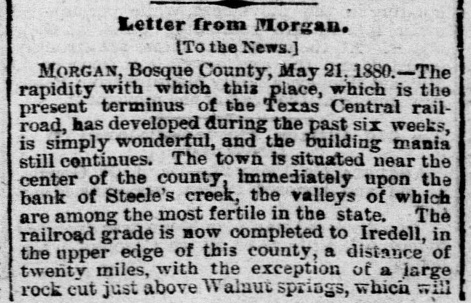 Galveston Daily News, May 28, 1880 |
Construction and Abandonment The Railroad Commission of Texas (RCT) was created by the Texas Legislature in 1891. One of the early rules RCT implemented was a requirement that railroads report their annual track construction and abandonment activities including details of specific segments built or removed. Around 1980, Charles Zlatkovich gathered RCT's records plus information from other sources to publish a book detailing railroad construction and abandonment in Texas. Since RCT did not exist until 1891, records for track laying and dismantling prior to that year presumably reflect RCT's early efforts to gather such information, supplemented by whatever additional sources Zlatkovich used. Drawing upon Zlatkovich's work, a table of railroad construction and abandonment in Texas through 2008 was published in 2011 by the Texas Transportation Institute (TTI) as an appendix to a report about policy and infrastructure issues pertaining to abandoned rail corridors in Texas. Although TTI's table is the best consolidated reference, errors and omissions in RCT's records initially compiled by Zlatkovich has led to mistakes in TTI's published data. An excellent example of these inaccuracies is the TC construction that passed through Morgan. The TTI table lists the segment as Ross to Albany, a distance of 178 miles, constructed in 1882. Since the Santa Fe construction from Temple to Ft. Worth is listed as having occurred in 1881, the implication is that the Santa Fe tracks arrived in Morgan perhaps a year earlier than those of the TC. Newspaper articles from the era tell a completely different story. An article in the Brenham Weekly Banner of March 26, 1880 anticipates that the TC would arrive in Morgan in April since the tracks were within four miles of the town. This is confirmed by an article in the Galveston Daily News of May 28, 1880 discussing the "mania" of local construction that had occurred in Morgan during the six weeks since the TC's arrival. Per Zlatkovich and TTI, Santa Fe's line from Temple to Ft. Worth was built in 1881. Work actually began in November, 1880 out of Ft. Worth. The date work began out of Temple has not been determined, but it reached Valley Mills in June and Morgan in August. Morgan is closer to Ft. Worth than Temple, but bridging the Brazos River created a significant delay for the southward construction through Cleburne. Work on the bridge had been underway at least since March when a contractor advertised for quarrymen ("apply at Headquarters, Brazos River, 12 miles north of Morgan") in the Galveston Daily News. It appears that this bridge may have been Santa Fe's final completion point to open the entire route between Temple and Ft. Worth. From the newspaper evidence, it is apparent that TC's tracks reached Morgan in April, 1880 and Santa Fe's tracks arrived there in August, 1881, sixteen months later. This timing is precisely the reverse of what would be expected based on TTI's table of construction and abandonment.  |
 LaGrange Journal, November 24, 1880 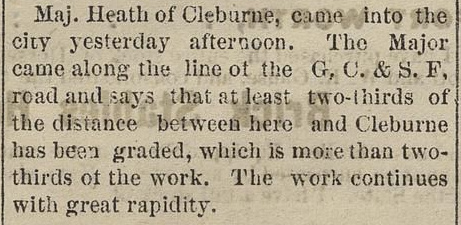 Ft. Worth Daily Democrat, January 25, 1881 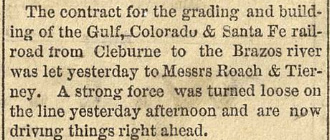 Fort Worth Daily Democrat, February 2, 1881  Galveston Daily News, March 27, 1881 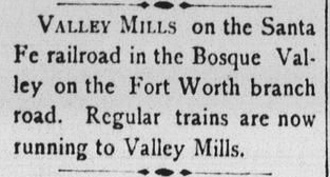 Brenham Daily Banner, June 24, 1881 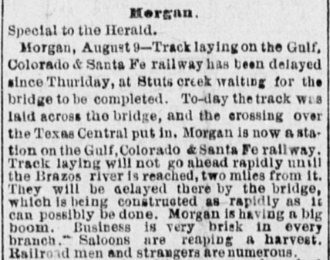 Dallas Daily Herald, August 10, 1881 |
In 1901, the Texas Legislature passed a law assigning RCT the responsibility of regulating crossings of two railroads (including those that were grade-separated.) The law gave RCT the power to mandate and prioritize locations for interlocker installations by the railroads. RCT also established procedures by which new interlockers would gain final approval for operation, and they specified information to be reported by the railroads annually for each interlocker. On July 20, 1904, RCT authorized Tower 50 to commence operation controlling the Santa Fe / TC grade crossing at Morgan. Tower 50 first appears in RCT's table of active interlockers dated October 31, 1904 published in their 1905 Annual Report. RCT's published reports do not specify the manufacturer of the interlocker at Morgan but they do state that it was installed by Santa Fe. The Tower 50 interlocker was an electrical plant with 20 functions spread over 16 working levers (two thirds of its capacity of 24 levers.) By the end of 1930, the Morgan interlocker had only increased to 26 functions in RCT's list dated December 31, 1930 (after which RCT no longer published this data.) Since the crossing had existed prior to 1901, the two railroads were required by law to share the capital expense for the tower and interlocking plant. They also shared the recurring costs for operating (staffing) the tower and maintaining the facility and equipment. There is no question that Tower 50 was a "Santa Fe tower", and RCT records do show Santa Fe as responsible for staffing the tower. Santa Fe undoubtedly performed all tower and interlocker maintenance as well.
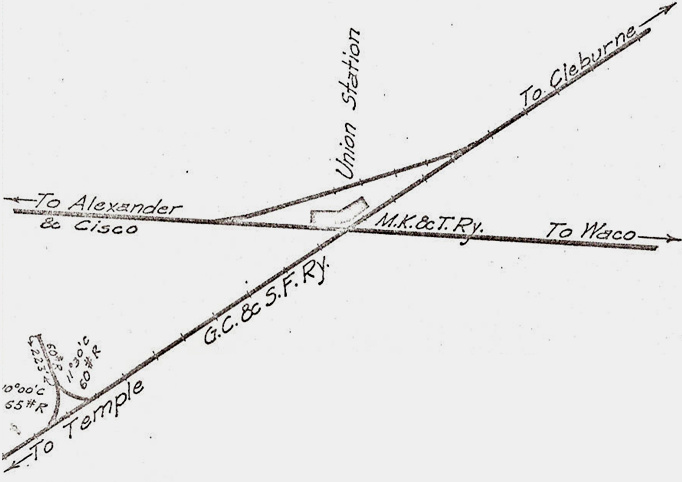 |
Left: This track chart of Morgan was created in
1915 by the Office of the Chief Engineer of the
Katy Railroad (courtesy of Ed Chambers). The chart identifies the Katy
("M. K.& T. Ry.") as the owner of the former TC tracks through Morgan;
the Katy had acquired the TC in 1910.
Below: The union passenger depot sat on the north side
of the crossing with a connecting track located behind it, about a half
mile southwest of the town center. There were no homes or businesses
near the depot; a gravel road about 0.2 miles long was built to reach
the depot from town. There is now a lengthy siding on the former Santa Fe line
through Morgan, hence two tracks are visible. (Google Earth, Dec. 2019)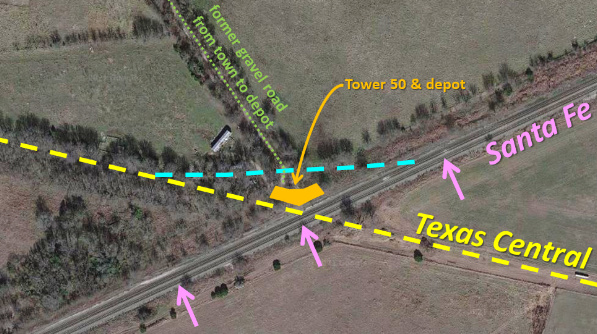 |
When the GC&SF reached Morgan, it had only been in
existence for eight years, having been founded in
Galveston in 1873.
Starting with a new bridge
over Galveston Bay, construction had proceeded west to
Arcola in 1877,
Richmond/Rosenberg in 1879 and then northwest to
Brenham in 1880. While the TTI table assigns 1881 as the year the GC&SF
completed both the 100 miles from Brenham to Belton and the 128 miles from
Temple to Ft. Worth, some of the work was done in 1880. The tracks into Belton passed through Temple, which was merely a construction camp
named for the railroad's chief engineer, Bernard Temple. Temple, however, became the branch point for the line north to Ft. Worth,
giving it Santa Fe tracks radiating out in three directions. As the tracks were
being extended westward beyond Belton to Lampasas (1882) and Brownwood (1885),
Temple was morphing into a significant city at the center of the GC&SF's
network. The much larger Atchison, Topeka & Santa Fe (AT&SF) Railway acquired
the GC&SF in 1887 and operated it as a
wholly-owned subsidiary until finally merging it in 1965. The former GC&SF tracks through Temple
remain in operational use, now owned by Burlington Northern Santa Fe (BNSF),
successor to AT&SF.
Beyond Morgan, the TC line toward the
Panhandle had crossed the Texas & Pacific at Cisco
and then stopped 33 miles farther north in Albany. Newspaper articles pinpoint December 20, 1881 as
the date the first train rolled into Albany. The TC soon discovered that operating a lengthy line through
sparsely populated territory was financially challenging. It entered
receivership in April, 1885 and continued to operate under court supervision. Six years later, the TC was sold to a committee of
bondholders. They in turn sold the northeast branch out of Ennis (which had not
yet reached Greenville) to New York investor Hetty Green who
used it to create the Texas Midland Railroad. The remaining branch to Albany was
deeded by the bondholders to a new Texas Central Railroad Company in January,
1893. The new TC added tracks from Albany to Stamford (1900), Stamford to
Rotan (1907), and De Leon to Cross Plains (1911.) The TC also built a new line from Ross to Waco
in 1903, giving them the opportunity for direct interchange with other railroads
in Waco rather than being dependent on the Waco & Northwestern at Ross.
In 1910, the Katy acquired 90% of the stock of the TC. They did not, however,
take control of the company until May 1, 1914 when the TC was leased to the
Katy's Texas-based subsidiary. This enabled them to comply with state law
regarding railroad ownership since the Katy was not a Texas corporation. The
Texas Central name continued to be used, but "the Katy" came into common
parlance as operations continued for
several decades. At least by 1956 and probably well before then, the Tower 50
interlocker had been converted to an automatic system.
Charles Wells
offers these recollections of riding Santa Fe passenger trains through Morgan in
the 1950s...(thanks, Charles!)
Trains 5 & 6, the Ranger, were the night trains I rode many times during the early 1950's to near their termination on May 29, 1960. My mother would put me on board #6 at Temple around 2:30 am bound for Ft. Worth to visit my aunt and uncle and my two cousins. I always rode the first coach so I could clearly see in the baggage car with their lights on and the engines with it's headlights and mars light on and the approaching signals. We would stop at Morgan just past the interlocking at the little platform and they would throw off mail and baggage and pick up the occasional passenger for Ft. Worth or beyond. Sometimes made a double stop if they caught the sleeper on the rear. Morgan was a regular stop, both north and southbound for 5 & 6, and was always well patronized and quite full! Northbound at Morgan was around 4:30 am and southbound about 12:40 am and both trains often met at Temple. When I rode the Texas Chief, trains 15 & 16, they never stopped at Morgan though did seem to slow down over the MKT crossing. Never saw a Katy train there but did see some cars on the interchange track several times.
Charles' observations suggest that some sort of depot was operational at Morgan in the 1950s. The combination depot and tower are gone but the date the structure was razed or removed has not been determined. Whether the original depot was replaced by some other interim structure also has not been determined; there is no depot visible on historic aerial imagery from 1965 (see below.) In 1967, almost all of the TC was abandoned, including the tracks through Morgan. About 25 miles of track between Gorman and Dublin was retained to serve the sizeable peanut industry located in those towns. The tracks remain intact, now operated by the Fort Worth & Western Railroad.
 Above: Bricks line the former union depot platform adjacent to the BNSF main line. The Katy crossed at an oblique angle passing through the trees beyond the tracks. Below: This 1965 image ((c) historicaerials.com) shows a structure at the crossing casting a shadow to the northeast. By this date, the depot and tower had been removed but the Katy tracks were still active. The shadow is probably from the cabinet for the automatic interlocker.  |
 Above: The Santa Fe crossed the Katy at approximately this location. This view down the BNSF track is to the northeast. The Katy grade to the east is visible in the gap through the trees. Below: A concrete signal base remains beside the Katy grade. The oblique angle of the crossing is apparent; the second BNSF locomotive is probably over the location of the diamond. (Tom Kline photos) 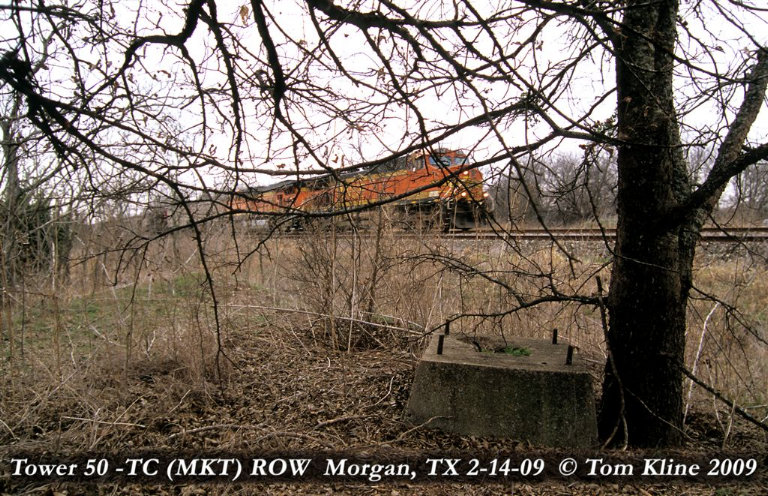 |
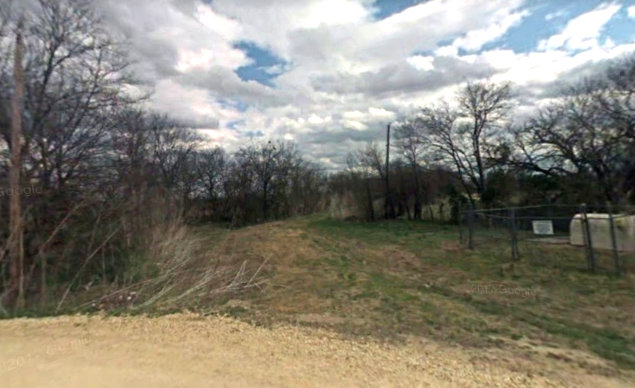
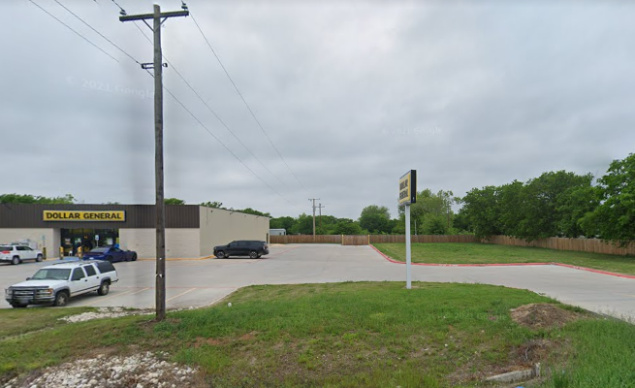
Above Left: A year before Tom's visit in 2009, this
is the road to the crossing as it appears in a 2008 Google Street View. It does
not appear to be maintained; the road ends in 0.2 miles at the tracks and there are no signals or
structures to be reached there, hence no apparent reason to maintain the road. Above Right:
These utility poles mark the path of the Katy / TC ROW looking west from FM
174 in the center of Morgan (Google Street View, April 2021.)
 |
Left:
This 1924 USGS topographic map shows the Brazos River between Whitney and
Morgan. The original TC routing (green highlight) went five miles
south-southwest out of Whitney and then made a right-angle turn to cross
the river on a north-northwest heading. Proceeding farther north (and
off the map) on that same general heading, the route skirted the west
bank of the Brazos before finally turning due west to
approach Morgan
along the drainage of Steele's Creek. The proximity of the tracks to the
river undoubtedly caused disruptions during floods that were common on
the Brazos. It also meant that the entire line through this area had to
be relocated (red dashes) once the decision was made to build Lake
Whitney. Lake Whitney was authorized by an Act of Congress in 1944, primarily for flood control but also for hydroelectric power generation. Construction of the dam by the U. S. Army Corps of Engineers began in 1947 and was completed by March, 1951. The new bridges over the Brazos for both the Katy (TC) and Santa Fe were still under construction at that time, so impoundment that initially occurred was limited. Presumably the existing bridges remained in service until the new bridges were ready.  When the TC was abandoned in 1967, the Katy bridge over the Brazos that had been built c.1951 was reused as a highway bridge over Lake Whitney for County Roads 1713 and 1409, along with portions of the ROW. East of the lake, the county road occupies about 3,100 ft. of ROW. West of the lake, a much longer section of ROW, about 2.5 miles, now carries the county road. The original TC grade can be seen on satellite imagery for most of its route between the connections where the new track departed from the original line. The east junction was on the west edge of the town of Whitney at 31 56 59N, 97 19 49W. The west junction is near Lakeside Village at 32 00 33N, 97 29 13W. At right, the new ROW (now CR 1409) crosses over the old ROW (green arrows) at 31 58 29N, 97 25 11W. (Google Earth, December, 2019) |


Above Left: Google Street View
from 2008 looking east across the Katy bridge that now carries FM 1409 / FM
1713. Above Right: drone shot
of the Katy bridge; click the image to be taken to the drone video on
Reddit r/drones.

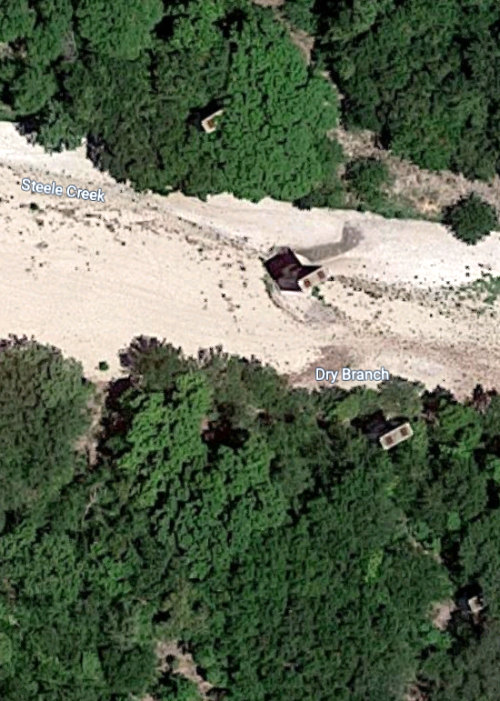
Above Left: Where the Katy
crossed Steele Creek south of Lakeside Village, these towering bridge piers were
left behind when the tracks were abandoned in 1967 (Mason Waldrep photo, August,
2023.) Above Right: This
Google Earth image from July, 2022 shows four of the piers. There is one
additional pier standing north of the creek. Historic aerial imagery from 1965 shows that the tracks
approached the bridge on large fills on both sides of the creek. The center pier
is
visible from Farm Road 56.
Right and Below: About twenty river-miles north
of where the Lake Whitney dam was built, Santa Fe's original Brazos
River bridge
was located across from the mouth of the Nolan River. Here, the river is
now ~ 1,000 ft. wide, still part of the lake. About
1,500 ft. beyond the north side of the bridge, the grade dropped low
enough that it would be inundated by the lake, hence Santa Fe built a
new bridge 7,000 ft. upstream, necessitating 13 miles of track
relocation (red dashes) and eliminating service to
the towns of Kopperl and Blum. The south connection was about 1.7
miles southwest of Kopperl at 32 03 22N, 97 31 25W. The north connection
was about 2.5 miles north of Blum at 32 10 36N, 97 23 09W. (USGS
1924 map/Google Earth)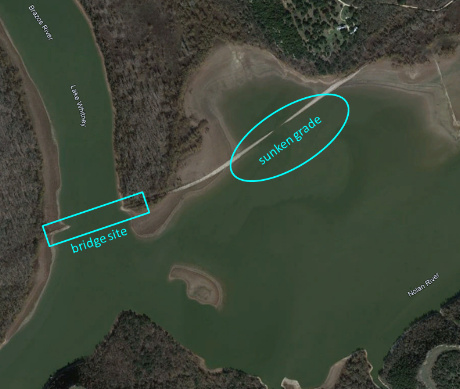 |
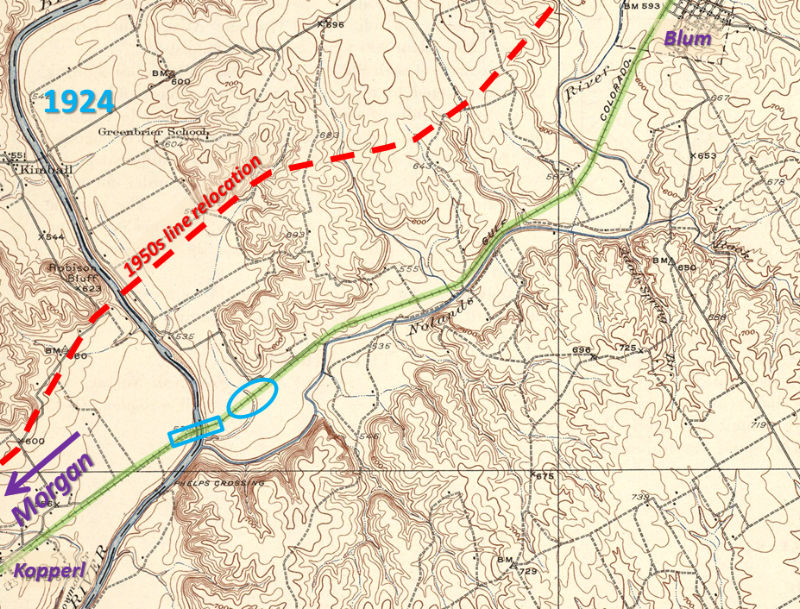 |
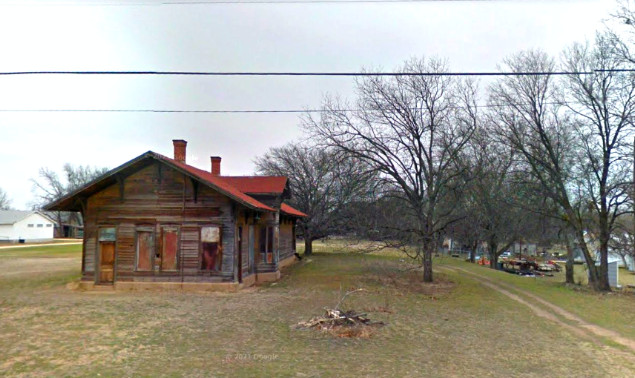
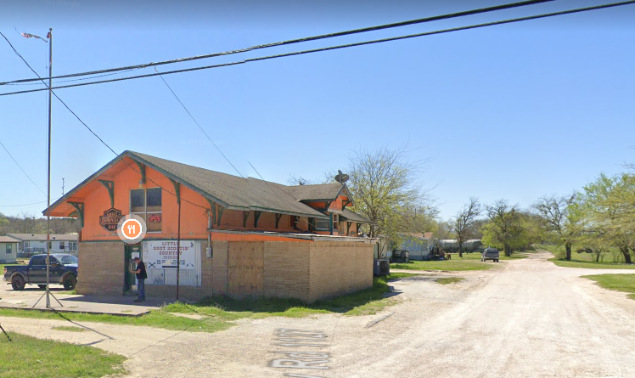
Above Left: The Santa Fe depot in Kopperl is abandoned
but still standing in this Google Street View of February, 2014. This view is
north along the Santa Fe ROW.
Above
Right: The Santa Fe depot in Blum has
been repurposed as the Redneck Grill and Bar, in business for several years. This view is south along the Santa Fe ROW. (Google Street
View, March 2021)